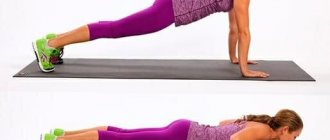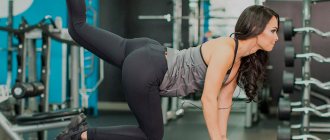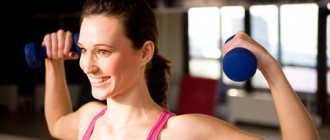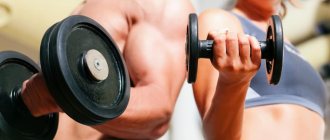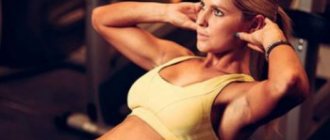Beginners often cannot decide on the choice of training program. There are many variations on the Internet: three-day splits, full days, top-bottom splits and others. Therefore, the question arises - “which program is the most effective” ?
In this article we will look at the types of training programs and their effectiveness. You will learn how to choose the right training program depending on your level of physical fitness and the number of workouts per week.
What is a training program?
A training program is a specific set of exercises that will help you achieve various goals, for example, increase strength, gain muscle mass, or prepare for competitions.
The training program allows you to systematically approach the training process
However, a good training program is not just a set of exercises, but also a number of required components:
- Individual load value. As a rule, ready-made programs on the Internet are a simple set of exercises, where the number of approaches and repetitions is written.
Such parameters are not enough, since the number of approaches and repetitions depends on your level of physical fitness. For example, if you are a beginner, then there is no point in training every day. Many ready-made programs on the Internet are designed for people with good physical data; such a high load is not suitable for beginners, as it can lead to overtraining. Therefore, the load is selected individually according to your parameters.Any good training program contains information about the goals, load levels and components described below.
- Instructions for progression of loads. Gradually, the body gets used to the loads, so they need to be increased so as not to get stuck in place.
For example, a person has been training with the same weight for several weeks. He did the required number of repetitions, the weight seems lighter with each workout. The muscles have adapted to the load, so you need to increase it.
If the load is not increased, the body will get used to it and will not develop. You will stop gaining strength, growing muscles, developing endurance, etc.
The training program should describe how to increase the working weight, the number of approaches and repetitions
Learn how to properly increase the load in training
- Duration of rest between approaches, exercises, training days. Many people forget to monitor rest intervals. However, these parameters affect the load level.
Find out how long to rest between sets
Power training
Many athletes, especially powerlifters, set themselves the goal of maximizing the strength of their muscles. To do this, it is necessary to take into account the peculiarities of organizing strength training.
The general strength of the whole body is better developed by basic exercises, which include not only the basics of triathlon (deadlift with a barbell, bench press, squats with a barbell), but also pull-ups on the bar, push-ups on the uneven bars, and standing military press.
When performing basic exercises, various schemes are used:
- 5 to 5 (the first is the number of sets, the second is the repetitions in them),
- 4 by 4,
- 3 to 3.
The pyramid principle is applied (gradually increasing the load and decreasing repetitions in the subsequent approach), but the main feature that unites them all is the low number of repetitions.
If the goal is to increase strength, it is enough to perform no more than 5 repetitions per set with maximum weights.
Loads with maximum intensity to the point of muscle failure, as already noted, specifically stimulate fast-twitch fibers and allow you to increase strength indicators.
Since when performing exercises in the strength mode, ATP is primarily consumed (an energy source that allows you to maximize all the body’s reserves, but is depleted during the first 10-20 seconds), it is recommended to rest for at least 3 minutes after each short-term set.
After strength training, it takes about 3-4 days for the fibers to fully recover , depending on the muscle group involved. You should train with intensive loading of the same muscles no more than 2 times a week.
Types of training programs
Types of training programs
There are two types of training programs: split and full body.
Full Body (fulbadi)
Fulbadi is training all muscles in one session.
Fulbadi - working all muscles in one workout
As a rule, the complex consists of 6-8 exercises. This version of the training program is great for beginners and allows them to quickly adapt their body to the load.
On our website there is a ready-made fullbadi program for beginners that you can start practicing. It is suitable for men and women.
Click to view the Fulbadi training program
Split
Split - dividing the body into parts and training them on different days
Split is the division of the body into parts and training them on different days.
Split is not suitable for beginners, since the load on the muscles is much greater than in full body. You can switch to split after mastering the exercise technique and several months of training.
Beginners have small weights on the barbell and small dumbbells, so split training is not practical. The workouts are not as intense.
There are many split options. Here are some of the most popular:
Classic split option
Day 1
- Breast
- Biceps
Day 2
- Back
- Triceps
Day 3
- Legs
- Shoulders
The second option for a three-day split
Day 1
- Breast
- Triceps
Day 2
- Back
- Biceps
Day 3
- Shoulders
- Legs
Four day split
Day 1
- Breast
- Biceps
Day 2
- Back
- Triceps
Day 3
- Shoulders
Day 4
- Legs
Five day split
Day 1
- Back
Day 2
- Breast
Day 3
- Legs
Day 4
- Shoulders
Day 5
- Hands
Split top/bottom
Day 1
- Upper body
Day 2
- Lower body
Cardiovascular training
This term refers to the heart (cardio) and blood (vascular), and is used in reference to how efficiently the heart pumps blood and how it then moves through the body. When we talk about cardiovascular fitness, we are talking about the heart and how it pumps blood. Activities such as running, cycling, dancing and aerobics make this system work harder.
Cardio fitness is aimed at making the heart pump blood more efficiently and maintaining this state for a long period of time, approximately 45-60 minutes.
Another way to do cardio is to alternate the intensity of your heart rate and blood flow levels, such as a quick, short session of activity alternating with a recovery run. This type of training is called interval training.
Running is always associated with cardio fitness, as most runners have a high level of cardio fitness, but this is not always the case. If you've been running for several years and your runs are the same distance at the same pace, your cardio fitness levels will decrease over time. It is known that when we work at a high level of cardio for ourselves, we breathe heavily, we feel hot and we sweat. It is under these conditions (a consequence of an increase in heart rate) that the fat burning process starts. Therefore, fitness for weight loss should make you sweat; regular walking on a machine, even for several hours, is not enough to get results.
Cardio fitness reduces the risk of cardiovascular disease and high blood pressure: it also reduces the risk of osteoarthritis and osteoporosis.
Checklist for selecting a training program
The selection of a training program is carried out in stages. Many people miss assessing their physical condition and determining their level of readiness for training. The type of training program and the amount of load depend on these parameters.
For you, we have compiled a step-by-step algorithm for selecting the optimal training program.
- Determine your level of readiness for stress. Without this, you will not select the required number of approaches and repetitions, or the type of training program.
- Determine your training frequency. Based on your capabilities (how many times a week you can train) and your readiness for stress.
- Choose a ready-made program or create your own. Based on the number of workouts per week and level of readiness, select the optimal type of program.
Select a training program
- Keep a training diary. It will help you record your current load and gradually increase it. Without this, the body quickly adapts, and training will not make sense.
Learn how to keep a workout diary
Basic types of training in the gym
What is a gym and what does it offer?
In general, there is no clear definition or scientific approach to the term gym. However, we can say for sure that this is a special room equipped with various devices, for example, exercise equipment, equipment and other things for physical exercise. And so visiting the hall has certain goals:
- weight loss;
- gain muscle mass;
- increasing endurance;
- form support.
Depending on this, the trainer in the gym or the athlete himself selects a training program that can achieve the desired.
Distinguish between two concepts of exercise:
- basic;
- isolated.
Conclusion
A training program is the basis for achieving any training goals.
While studying according to the program, you will be able to gradually increase the load and monitor its dynamics, which is one of the conditions for progress. The training program must be selected based on the current level of readiness for stress, frequency of training per week, availability of equipment, etc. Therefore, you need to approach your choice responsibly. Your future success depends on this.
If you are choosing a program for the first time, then contact a trainer who will help you create the right program and tell you how to increase the load, select working weights, etc.
What should a workout be like to gain muscle mass?
The problem of gaining weight is quite common among both beginning athletes and professionals. Of course, an advanced athlete will achieve his goal many times faster, and there is a completely logical explanation for this - a qualitative understanding of the theoretical foundations.
Working in the gym for weight differs from strength training solely in the number of repetitions in the approaches. The growth mechanism of muscle fibers is activated when fast-twitch fibers are converted to slow-twitch fibers.
In the classic version, you should perform from 8 to 12 repetitions in one approach. It is this intensity of training that provokes blood flow to the fibers, which leads to their thickening and an increase in the density of capillaries in the muscles.
Let's make an adjustment for the influence of individual characteristics: the given figures are valid for most subjects, but in some cases they may deviate slightly, so do not be afraid to experiment with both the working weight and the number of repetitions.
As for rest between sets, 2-3 minutes will be enough.
With regard to muscle recovery, everything is also simple here: small muscle groups, such as the gastrocnemius, biceps and triceps muscles should rest for at least 48 hours, and large muscle groups: pectoral, latissimus and quadriceps muscles - from 72 hours or more.
Fitness training
A very popular form of physical activity among women. Fitness is aimed at keeping the body in good shape, achieving good health and maintaining health. Today, the types of fitness training tend to be infinite in number. This type of physical exercise has an incredible number of varieties.
Surprisingly, fitness classes also refer to workouts done in gyms. And all because most types of direction are impossible without auxiliary means - such as dumbbells, fitballs, etc.
Fitness is an excellent option for those who want to work only with their body, are not chasing bulging biceps and want their figure to look toned.
Strength fitness and aerobics
The main law of fitness is the principle of harmony.
That is, all exercises performed must be combined with each other and must be aimed at developing and improving the functioning of the cardiovascular system and human strength. Approximately 50% of available classes are aimed at developing strength. All exercises are aimed at developing the muscles of the abdomen, back and upper body. In this case, the following sports equipment is used for training:
- Dumbbells. (Their weight varies).
- Barbell pump.
- Medical balls.
- Kettlebells.
- Expanders. They are used rarely and often to increase weight.
All exercises without exception are performed without stopping. Classes are always accompanied by cheerful, rhythmic music. At the beginning, there is always a warm-up to warm up the muscles, and a cool-down at the end of the workout.
Programs with elements of oriental martial arts
The peculiarity of this type of fitness training in the gym lies in the following nuances:
- Aerobics is performed, or rather exercises incorporating elements of martial arts.
- For example, aerobics with elements of boxing, karate or kickboxing.
- This type of training program allows you not only to improve the physical development of your body, but also to master types of martial arts that can be useful for self-defense.
Flexibility programs
Exercises in this type of training are aimed at:
- Developing the mobility of your joints.
- Giving elasticity to muscles.
- Improved condition of tendons and muscles.
- Improving the functioning of our entire body.
The flexibility program allows you to avoid the following diseases:
- Athritis;
- Arthrosis;
- Diseases associated with the human musculoskeletal system.
"Smart body" program
Professional trainers classify this type of fitness training in the gym as a group of gentle fitness.
Exercises will help:
- Relieve stress, for example, after a hard day at work.
- Improve the physical development of your body.
- Stabilize mental state.
- If all exercises are performed correctly, it is even possible to get rid of many diseases.
This complex includes yoga, which is so popular these days, as well as Chinese gymnastics called “Wushu”.
What is the distinctive feature of this complex from those described above?
All exercises that have been specially designed are aimed at achieving relaxation and achieving meditation.
Types of health aerobics
The main types of training in this area:
- Water aerobics - indicated for thin blood vessels, obesity, varicose veins. Suitable even for pregnant women and the elderly.
- Tai-bo is a technique based on various elements of martial arts.
- Tai chi is a type of gymnastics that came from Ancient China. Combines meditation and physical activity. Helps improve the condition of the cardiovascular system.
- Kick aerobics is a high-intensity workout that puts stress on the joints and spine. Increases endurance and strength, develops flexibility, dexterity and coordination of movements.
- Step aerobics - includes very simple exercises that are performed on special platforms.
- Dance aerobics - performed to various music, improves coordination and plasticity, promotes fat burning.
- Slide aerobics - based on strength exercises reminiscent of the movements of speed skaters, roller skaters or skiers. Classes take place on special tracks.
- Fitball is a set of exercises that are performed using special inflatable swords.
